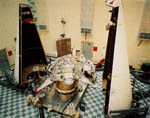




We
need to consider two cases:
On
Earth, before launch to another world, in order to prevent Earth microbes
being transported elsewhere.
On
return to Earth from other parts of the Solar System, to prevent Earth
from contamination by alien life.
The two situations are so different that we need to review each one separately.
Before Launch...
On Earth we can build spacecraft in special sterile facilities. We can decontaminate each component as it is assembled to the spacecraft, and we can test for any remaining contamination. We can control the environment and we have time and opportunity to carry out additional decontamination procedures, should any problems show up.

Surveyor 3 final assembly in a clean room. © NASA
Various
methods of decontamination are used:
disinfectant solutionsirradiation, usually with UV light but sometimes
with X-rays and gamma radiation heat
treatment
It
should be pointed out also, that all spacecraft are assembled in clean-rooms,
regardless of whether they are on a rendezvous mission with another world.
This is to protect their delicate systems, which can be damaged by particles
the size of those in cigarette smoke.
On return...
For spacecraft returning to Earth from a rendezvous with a distant object in space - a comet or planet, for instance - the problem is totally different. There is no access to clean rooms, human intervention is not possible, and most standard sterilization treatment methods are not applicable.

Luna 16 was designed to return soil samples from the moon. © RSA
There are several ways that contamination can be prevented. The first and most obvious is not to bring the spacecraft back to the Earth itself. A returning spacecraft could easily rendezvous with an orbiting space station, and its cargo could be transferred in orbit. Returned soil and rock samples could be transferred directly via an airlock to a sealed examination chamber and the sample could even be examined in space, without ever coming to Earth. The discarded return module could then be blasted out into space, away from Earth, or sent on a trajectory that would ensure its destruction by burning in the Earth's atmosphere on re-entry.
An automated transfer system is also feasible. Here a spacecraft could launched from Earth to rendezvous with the returning module with its precious cargo aboard. This could encapsulate and seal off the entire return module, or just the cargo container, and return it to Earth in a sealed chamber. This would then be opened in the isolation laboratory.
If, however, the returning module is going to touch-down directly on Earth, then its exterior will need to be decontaminated by remote control during the return journey. The simplest way to do this is to design a return module that is completely smooth, and then expose it to the Sun's radiation for the duration of the return flight. This includes harsh UV, which should be strong enough to kill most micro-organisms unless they are inside a protective lump of soil stuck to the return module. Teflon and other non-stick coatings on the outside of the return module should reduce this possibility, though.
Another possible way of ensuring a clean exterior to the return module, is to house it inside a second stage of the return spacecraft. It would then remain in sterile conditions throughout its entire mission. The return spacecraft would blast off the body it had visited, then when safely in transit back to Earth, it would eject the clean return module.
Another
alternative is to allow the heat of re-entry through the Earth's atmosphere
to sterilize the return module. Other methods have also been
proposed, including the unlikely expedient of coating the return module
in pyrotechnic materials that burn up sometime during the return journey,
thus destroying any living thing clinging to its surface.
Go
to
Home
| Space Station
| Mars | Rainforest
© 1999 Satellite Events Enterprises Inc.
